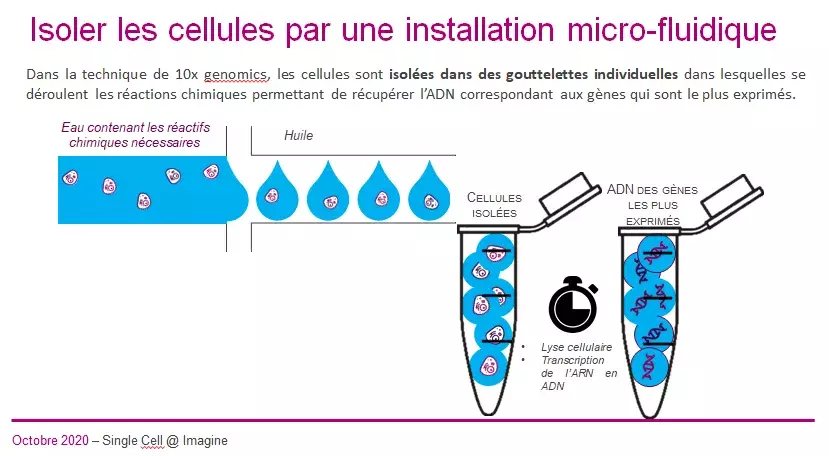Published on 11.08.2021
On 14 October, Institut Imagine, Europe's leading center for research, teaching and care on genetic diseases, welcomed Pierre-Antoine Molina, Prefect and Secretary General for Public Policy of the Prefecture of the Ile-de-France region, and the President of the Ile-de-France Region, Valérie Pécresse, to inaugurate a technological pole that is unique in Europe. The LabTech Single-Cell@Imagine brings together human and technological skills and equipment to analyse the expression of thousands of genes cell by cell. This LabTech enables Mickaël Ménager, its director, and other researchers to plunge into the heart of cells with unprecedented precision and to take a fresh look at genetic diseases.
"With single-cell analysis, we are changing the scale of our understanding of diseases," says Mickael Ménager, Inserm researcher, director of a research Lab and of Single-Cell@Imagine. He presented this new LabTech, unique in Europe, to Pierre-Antoine Molina, Prefect, Secretary General for Public Policies of the Prefecture of the Ile-de-France Region, and to Valérie Pécresse, President of the Ile-de-France Region, on 14 October. This laboratory has received support of 0.6 million euros as part of the SESAME Filières PIA call for projects in 2019, and will be accessible not only to all Imagine laboratories, but also more broadly to all researchers in Ile-de-France, both academic and industrial.
The technology developed by 10X Genomics and implemented at Institut Imagine with this laboratory gives researchers the ability to establish a real cellular ID for a given individual. In one go, researchers can analyse the expression of thousands of genes on more than 10,000 cells per individual. This cellular information will complement the patient's other data: clinical data, genetic data, etc. The ID thus obtained can be compared with that of various known pathologies in order to make a diagnosis.
Thousands of informations on the activity of each unit
This technology is also set to become a therapeutic decision aid by facilitating the choice of the treatment best suited to the patient's cellular condition. Common points between certain diseases previously considered to be totally different could be discovered and open up new avenues of treatment.
"It is a unique technological development laboratory that strengthens Institut Imagine's skills in research on genetic diseases. Single-Cell analysis appears to be one of the pillars for the development of a truly personalized medicine that takes into account as much data as possible about the individual and his or her disease," explains Professor Stanislas Lyonnet, geneticist and director of Institut Imagine.
The answers to questions about the origin of the disease, why it does not respond to this or that treatment, why the disease does not evolve in the same way as in another patient are sometimes found in a single type of cell. Cell-by-cell analysis, with the considerable amount of data this represents, will take genetic diseases to a new level of understanding.
A possible prognostic tool for the most severe forms of the multi-inflammatory syndrome (Kawasaki type syndrome) triggered in some children infected with SARS-CoV-2.
A project is currently underway to use this technology to improve the prognosis of young patients who develop Kawasaki syndromes (or associated forms) after being infected with SARS-CoV2, and more specifically acute myocarditis. Indeed, this very severe complication is observed in almost half of them.
Thanks to the single-cell, researchers hope to be able to identify children at risk of developing this inflammation of the myocardium at an early stage, and thus anticipate or even adapt treatments. The difference in cell profiles could be used to identify the profile linked to these severe forms and, for each new patient, identify those at risk of developing a severe form.
A technology based on micro-fluidics
The patient's cells are isolated in individual droplets in which chemical reactions take place to recover the DNA corresponding to the genes that have been expressed the most.
Within each droplet, a magnetic bead with a unique bar code fixes the transcribed DNA, so that the collected DNA fragments can be analysed at once and then reassigned to the initial cell. Bioinformatics allows the complete analysis of this data and the generation of identity cards of the individual's cellular state.

